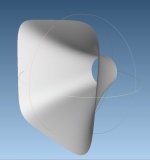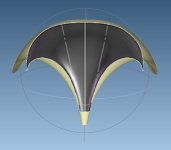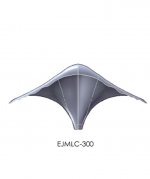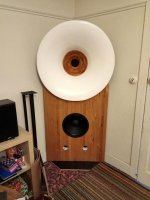IWATA-JMLC 300 overlay and EJMLC for comparison (not to scale).
Attachments
Last edited:
That was sad. Such great drivers, such potential, such a bad crossover. 🙁Here's a comment by John Sheerin on the GOTO full horn system that Pano got to listen to at Capital Audio Fest 2010:
Believe me, it did not sound "thin" - it sounded shrill. Ear piercingly shrill. It was difficult to listen to for long. There were a lot of mumbled comments about it that weekend. I asked the gentleman who had set up the system why it sounded so off and he admitted that he had missed the mark on the crossovers. His pre-planning had been wrong. Maybe the room got the better of them, but it sounded mostly like level mismatches to me. Really too bad."I got it to the point where I thought it was subjectively flat in-room based on outside measurements, but the problem with that is that if you don't play music at realistic levels it will then always sound thin."
It was this system, I believe?

3 extremely expensive compression drivers + a pair of hornloaded woofers per side... and yet it s..ks 😉
Honestly, it doesn't surpise me in the least.
It's illustrative for the reasons why I would (probably) never build a multiple (>3) horn system. It takes an enormous amount of time and know-how to get these right. That's not to say it can't be done, the Living Voice Vox series are exemplary.
I attribute the "earpiercingly shrill sound" primarily to a bad implementation/integration of the upper two horns, thus excluding the supertweeter.
JMLC's comment is telling.
John Sheerin undoubtedly tried to make the most of it, his knowledge and skills are beyond dispute. Check the built-in speakers of the latest MacBook Pro and start wondering whether he actually succeeded in breaking Hoffman's iron law.
This:
" I did this to try to maximize the sensitivity of the system for low power amps."
suggests the big trumpet (midhorn) was way too loud relative to the other channels and probably also used outside of it's optimal range, which is very small to begin with.
Dump the trumpet to make room for a radial type of midhorn (Iwata, Arai, Yuichi) and the ingredients for a nice(r) multiple horn recipe will be much easier to blend.

3 extremely expensive compression drivers + a pair of hornloaded woofers per side... and yet it s..ks 😉
Honestly, it doesn't surpise me in the least.
It's illustrative for the reasons why I would (probably) never build a multiple (>3) horn system. It takes an enormous amount of time and know-how to get these right. That's not to say it can't be done, the Living Voice Vox series are exemplary.
I attribute the "earpiercingly shrill sound" primarily to a bad implementation/integration of the upper two horns, thus excluding the supertweeter.
JMLC's comment is telling.
John Sheerin undoubtedly tried to make the most of it, his knowledge and skills are beyond dispute. Check the built-in speakers of the latest MacBook Pro and start wondering whether he actually succeeded in breaking Hoffman's iron law.
This:
" I did this to try to maximize the sensitivity of the system for low power amps."
suggests the big trumpet (midhorn) was way too loud relative to the other channels and probably also used outside of it's optimal range, which is very small to begin with.
Dump the trumpet to make room for a radial type of midhorn (Iwata, Arai, Yuichi) and the ingredients for a nice(r) multiple horn recipe will be much easier to blend.
Last edited:
To ensure the direct radiating backloaded woofers and tweeter horns are properly aligned with the deep trumpet, either a lot of in-room tweaking, or a horn magician is required.
Last edited:
I finally got some chatter going on the TL forum, it still sounds like I should be able to assume some accuracy using Hornresp and intended outcome though I'll be folding the line.
I brought up the comment about TL's and some opinions on the midrange being lacking and the comment was basically made "how is that a fault of TL"...lol
So...TL seems to be the ****, it kills two birds with one stone, as long as I can make it fit I think I'll commit.
I brought up the comment about TL's and some opinions on the midrange being lacking and the comment was basically made "how is that a fault of TL"...lol
So...TL seems to be the ****, it kills two birds with one stone, as long as I can make it fit I think I'll commit.
TLs are popular amongst fullrange afficionados.
I can't think of a reason why the midrange would suffer.
You're probably not going to stick to a single fold? 😉
I can't think of a reason why the midrange would suffer.
You're probably not going to stick to a single fold? 😉
I finally got some chatter going on the TL forum, it still sounds like I should be able to assume some accuracy using Hornresp and intended outcome though I'll be folding the line.
I brought up the comment about TL's and some opinions on the midrange being lacking and the comment was basically made "how is that a fault of TL"...lol
So...TL seems to be the ****, it kills two birds with one stone, as long as I can make it fit I think I'll commit.
If you intend to use a quite extreme MF/HF horn then more in the line would a corresponding bass horn like this:

View attachment drba_SWH80_PE_basshorn.zip
The back side of the driver could be loaded with an U-frame or Y-frame like chamber to support the driver and to lower the resonance frequency. I like the effortless sound of an dipole. The downside is always lower efficiency.
Nice concept docali!
I've just finished this short thread about TLs.
camplo, you might want to read it too, if you haven't already.
I've just finished this short thread about TLs.
camplo, you might want to read it too, if you haven't already.
Last edited:
This is close to what the goal of this thread is.. I scored a pair of old azurahorn-160s, made a conical insert to adapt a pair of 5 inch PRV 5MR450-NDY to the 8 inch opening, and underneath them is a 220L ported corner enclosure for a faital 15PR400 - crossed over at around 300-350hz (slowly working on the crossover)
It's an awesome sounding setup, basically constant directivity and I believe the crossover is low enough that the bass driver is partially corner loaded by its position in the room. Certainly capable of high (home) SPL from about 30-15000hz
It's an awesome sounding setup, basically constant directivity and I believe the crossover is low enough that the bass driver is partially corner loaded by its position in the room. Certainly capable of high (home) SPL from about 30-15000hz
Attachments
This is close to what the goal of this thread is.. I scored a pair of old azurahorn-160s, made a conical insert to adapt a pair of 5 inch PRV 5MR450-NDY to the 8 inch opening, and underneath them is a 220L ported corner enclosure for a faital 15PR400 - crossed over at around 300-350hz (slowly working on the crossover)
It's an awesome sounding setup, basically constant directivity and I believe the crossover is low enough that the bass driver is partially corner loaded by its position in the room. Certainly capable of high (home) SPL from about 30-15000hz
That tiny fullrange driver on steroids has intrigued me eversince it was launched, years ago.
xrk971 did some interesting things with it.
Am I to understand that your insert hosts 2 PRVs (per horn)?
Last edited:
That tiny fullrange driver on steroids has intrigued me eversince it was launched, years ago.
xrk971 did some interesting things with it.
Am I to understand that your insert hosts 2 PRVs (per horn)?
Just one per horn 😀
They are covered in grille cloth to hide the logo on them
It is an amazing driver, i don't know of anything similar or even in the same league.. on these horns with small rear chambers they are like a cross between a cone driver and a compression driver when it comes to dynamics and sensitivity with low distortion
Yes, that I can imagine.
Do you have some measurement data of these?
I wonder if the hornloading + rear chamber smooths out cone breakup and/or pushes the modes upwards.
It would also be interesting to see the polars.
I assume there's no phase plug in front of the cone?
You've basically created something similar to the BD-Design Oris horns.
I remember suggesting the PRVs to replace the (PITA) Lowthers that a friend used with his diy wooden Oris horns.
Do you have some measurement data of these?
I wonder if the hornloading + rear chamber smooths out cone breakup and/or pushes the modes upwards.
It would also be interesting to see the polars.
I assume there's no phase plug in front of the cone?
You've basically created something similar to the BD-Design Oris horns.
I remember suggesting the PRVs to replace the (PITA) Lowthers that a friend used with his diy wooden Oris horns.
Last edited:
The organic sound of "paper" throughout the vocal range is exactly what I like about Funktion One systems, provided there's an abundance (and thus expensive) amount of headroom incorporated in the system design. In case of an undersized system the hornloaded paper cones are often pushed way out of their comfort zone, with disastrous consequences.
Last edited:
Yes, that's the one. Funny that I remember the woofers better than the horns. 🙂It was this system, I believe?
I had forgotten that John did the crossover, probably because he was not the person I spoke to in the room. I'm still convinced that it was mostly a level mismatch, tho there might have been some response shaping missing on the horns. It would have been fun to work on getting them tuned better. Perhaps it's a good thing for me they weren't sounding better, for had they been optimized in that room, I might still be in love and pining away that I could never afford them. 😀
FWIW, my buddy Poinz (known here for his Musical Machine amp) showed me photos of a system he visited in Cyprus. All horn, right down to the bass. I think it was Goto and/or ALE drivers. There was a funny shot of the bass horn and driver sticking far, far out of the back of the house.
The organic sound of "paper" throughout the vocal range is exactly what I like about Funktion One systems,
I have never experienced Function One system other than the large venue installation, do you prefer it over ATC mid dome for domestic listening?
Yes it is.This is close to what the goal of this thread is.
 I'm intrigued and missed seeing this fun driver completely. Now I want to go do Hornsrep sims.
I'm intrigued and missed seeing this fun driver completely. Now I want to go do Hornsrep sims.A few years back I heard a field coil Lowther in a large horn in Dave Slagle's room. It was amazing. Superb balance, delicate details, the lot. Very impressive.
Interesting! Could you elaborate on this? I always thought that such cabinets are similar to bass reflex. What about Altec 816/817. Are these also no bass reflex cabinets?
This is close to what the goal of this thread is.. I scored a pair of old azurahorn-160s, made a conical insert to adapt a pair of 5 inch PRV 5MR450-NDY to the 8 inch opening, and underneath them is a 220L ported corner enclosure for a faital 15PR400 - crossed over at around 300-350hz (slowly working on the crossover)
It's an awesome sounding setup, basically constant directivity and I believe the crossover is low enough that the bass driver is partially corner loaded by its position in the room. Certainly capable of high (home) SPL from about 30-15000hz
Another interesting driver I've been playing with is the Dayton PS65LP.
Dayton Audio PS65LP-4 6-1/2" Ultra Efficient Low Profile Full-Range Driver 4 Ohm
Very nice neutral detailed sound. Impressive off-axis performance as well.
- Home
- Loudspeakers
- Multi-Way
- Is it possible to cover the whole spectrum, high SPL, low distortion with a 2-way?


